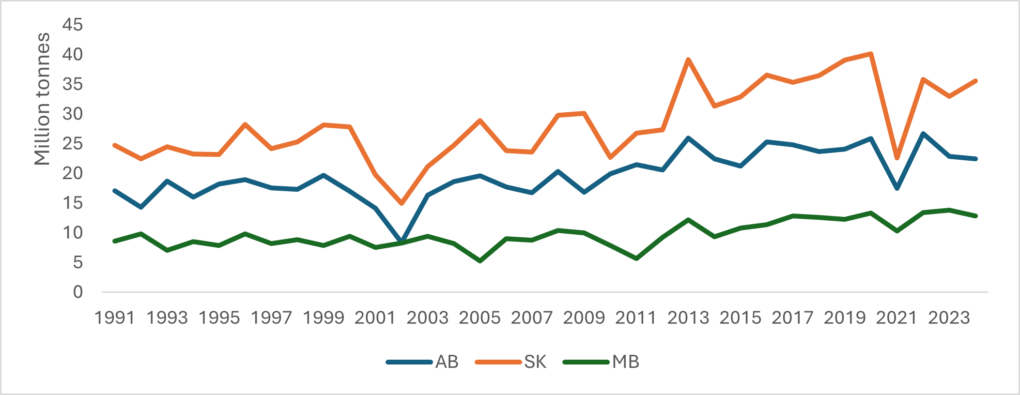We need your assistance to better inform policy makers.
Over the past 30 years, Prairie farmers have been continuously adopting new technologies and practices that have contributed to improved economic and environmental sustainability. Key adoptions include zero-till, continuous cropping in place of summerfallow, herbicide-tolerant (HT) crops, precision agriculture technologies, and using less toxic chemicals. From an environmental standpoint, these agricultural advancements have contributed to increased soil carbon sequestration, helping to offset positive carbon emissions, reductions in the environmental load of pesticide use, and improved soil quality. At the same time, production levels have increased to meet the demands of the growing global population.
Significant steps toward improving the environmental footprint of agriculture were taken in the ten years prior to 2005, in which HT crops had just been introduced and zero-till was being widely adopted. Thus, the major land use changes that contribute to improved carbon sequestration and improved soil quality had already occurred. However, policies and international agreements aimed at reducing climate change do not typically recognize adoptions and improvements made prior to 2005, a common baseline year in international climate agreements.
The Crop Rotation Survey
The Crop Rotation Survey, hosted by Dr. Stuart Smyth and his research team at the University of Saskatchewan, collects farm management data on all operations within a crop rotation, including seeding, fertilizer, tillage, chemical use, and harvest. The goal of the survey is to inform the public and policy makers about how farm management practices, innovation, and new technology adoption have changed and become more sustainable in the last 30 years on the Prairies.
The first Crop Rotation Survey was launched in 2020. Initially, we collected data from the time periods of 1991-1994 and 2016-2019, the former period being the years just prior to the introduction of genetically-modified herbicide-tolerant (GMHT) canola, which helped to highlight the positive contributions of this technology.
Thanks to the participation of over 200 Prairie farmers, the results from the first survey highlighted environmental improvements from zero-till adoption, reductions in summerfallow, fertilizer use efficiencies, and more sustainable pesticide use. The results received interest, both locally and internationally, from consumers, academics, and policy makers.
We Need Prairie Farmers' Help Again
We are launching a new version of the Crop Rotation Survey this fall, this time collecting data from the 2004-2006 and 2020-2024 time periods. We are asking Prairie farmers to consider participating in the survey and sharing their crop production data with us. The research will once again be used to inform policy makers and the public about the changing nature of agriculture, farmers’ innovative adoptions and practices, and how agriculture is continuously improving its environmental footprint. Expanding the number of participants as well as the years of data collected provides a clearer picture of Prairie agriculture and improves confidence in our results.
Data from the 2004-2006 years is especially important in this round of data collection. A number of international climate agreements, such as the Paris Agreement, use 2005 as the baseline year for emission reductions target. In the Paris Agreement, Canada’s target is to reduce greenhouse gas (GHG) emission levels by 40-45% below 2005 levels by the year 2030. Environmental policies are implemented with this target in mind. However, in agriculture, significant steps to reduce GHG emissions, including adopting zero-till practices and removing summerfallow, had already occurred on a large scale prior to 2005. Yet these pre-baseline adoptions are typically not considered in policy discussions. Our goal is to quantify and communicate how much farmers had already contributed to Canada’s environmental goals by 2005, and how efficiency improvements continue to contribute to these goals.
How Can I Get Involved?
We need farmers from all demographics and regions of the Prairie Provinces to participate in this round of surveys to ensure the most representative sample possible. Although we are asking for data from two separate time periods, farmers do not need to have been farming in both time periods to participate. We have simplified the survey this time around, but the nature of the data collection and types of questions remain the same. We expect the survey to take between 2-4 hours to complete depending on the years of active farming. Compensation of up to $200 is available for farmers who complete all sections of the survey.
In a volatile world, where more food is required every day to feed the growing population, environmental concerns are at the forefront of policy decisions, and agricultural advancements are often viewed negatively, farmers need their voices to be heard. Through the Crop Rotation Survey, we strive to provide a platform to share a united voice for Prairie farmers regarding important topics including net GHG emissions, fertilizer and chemical use, and soil health and quality. By participating in the survey and sharing your data with us, you help to make farmers’ voice stronger.




